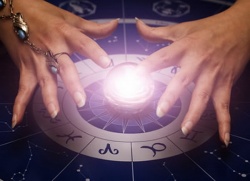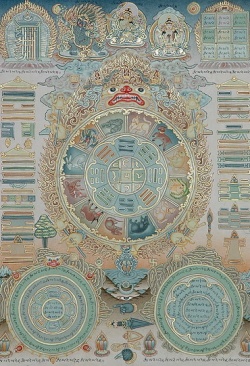About Geomancy
Many people today care about sacred places, and want to know more about them. In an apparent reversal of the secular ethos of our culture, forgotten holy wells are being made to flow again, old stones are discovered and protected, and pilgrim paths are being trodden once more. At the same time, research into sacred space is the subject of enquiries from a number of disciplines, both academic and amateur - amongst them, the one known as geomancy, or earth mysteries. This is a study of books and articles published over a period of five years which may be of interest to geomantic researchers.
Defining geomancy has puzzled wiser heads than mine - each of the journals covering the subject will be found to have a different account on its title page. There is general agreement that geomantic research lies at the crossroads, so to speak, of other sorts of enquiry. It is roughly equidistant from geography, anthropology, theology and physics. Traditionally, it has had very close relations with prehistoric and theoretical archaeology.
Many researchers in the field get by without any abstract notion of the discipline at all. They know what interests them and others, and are not troubled as to whether certain subjects are or are not geomantic. But a straightforward approach like this would not have helped me scan bookshelves or bibliographies looking for the material presented here. Without some formal parameters, how would I know what it was I was supposed to be looking for? And so - without presuming to codify or alter anyone else's perceptions on the subject - I would suggest that geomancy can be defined, and that it has four key factors.
Firstly, geomantic sites are real, particular places, either created as monuments and architecture, or distinguished as natural landscape features.
Secondly, these places count as geomantic sites because of something special about them - a sense of the Other. Call it sacred or magical, numinous or paranormal, it is this spiritual quality which is the subject of our research.
Thirdly, ours is genuine research, the kind which involves facts and theories. However important an imaginative response may be in directing our attention to places, our actual discussion of them involves verifiable statements.
And fourthly - this one is crucial, but not so easy to define - it is the sacred identity of the holy place itself which matters for geomantic researchers. The sacred presence is not to be understood as a metaphor, a consequence, or a reflection of some other factor - it is a powerful, direct image of truth.
I would lay special stress on that fourth factor, because it is so contrary to everything that is learnt in school and at college. In our official culture, the sciences study nature, and the humanities study people, but no provision is made for the intelligent study of the supernatural. Quite the reverse, in fact. Material appearing in this text from the specifically geomantic journals and books can be understood as an attempted reversal of the world’s judgement on that matter; but much of what is presented here was derived from other sources. So when academic references are adduced in support of geomantic ideas it means that they have (in a quiet sort of way) been subverted. Placed in their original context, such writings belong to traditions which - sometimes bluntly, and sometimes with great subtlety - deny the empirical existence of sacred space. Though they may deny that it exists, they can be very detailed in describing it. Now it is time for us to pass gently along the academic bookshelves, to steal knowledge from the cradle of rationalism and to bring it up in a very different world, among certain radical pamphlets which seek to turn the secular world upside down.
Geomancy is different, and it is worth remembering this, because at first glance it appears so similar to other work done recently within the rationalist or humanist paradigms of conventional research. There is something more to the material set out below than a theoretical archaeology of ritual landscapes. It is not a geographical contribution to the anthropology of religion, either, nor should it be read as a psychology of traditional approaches to architecture and territory. Some entries may have been originally written for just those purposes, and written by people of great intelligence and ability. But here I have brought them, like changelings, into a more haunted world.
A Geomantic Bibliography
The twelve chapters below illustrate different themes in geomancy, citing both books and articles. About a third of the articles, and a smaller proportion of the books, are by researchers into geomancy, while the rest come from other streams of scholarship. As a bibliography, it is hoped that it will help researchers who have met with any difficulty in finding out what has been done or said in this wide-ranging field. The problem came home to me in about 1996, during correspondence with some fellow workers. I had come across one or two of the books featured here, and realised that they had not been reviewed in the usual geomantic journals or cited in anyone else's work, though they were clearly of a kind to excite any student of sacred space. Pleased enough at my discoveries (and maybe they were not so much of a discovery after all) I was ready to send off a note to the standard bibliographical update on the subject, when a thought struck me - there was no standard bibliography. Maybe one would be prepared at some future date, but here and now nothing would happen unless I made the attempt. So you may imagine me, holed up in a succession of libraries and bookshops, entertaining myself (like Samuel Johnson on that better errand, the English Dictionary) in fancies of ‘the treasures with which I expected every search into these neglected mines to reward my labour, and the triumph with which I should display my acquisitions to mankind’. Even the Doctor, however, soon found that ambition will exceed performance in a work of this kind: and how much more so in geomancy, where the dedicated researcher must begin by drawing widely on history, anthropology, geography and archaeology, before moving on to theology, psychology, folklore and paranormal studies. To review all the relevant literature published each year would take much longer than twelve months, and the perfect geomantic bibliography, like Tristram Shandy’s manual of childcare, must remain forever in manuscript, outstripped by the growth of its subject.
It is not such a labour to cover the heart of geomancy, the five or six journals published by those who are actually working within the tradition. About three or four dozen regular researchers make up this community; in addition to the periodical literature, there are up to ten books, long or short, written each year - all without the benefit of academic subsidy. It is not the same environment as that in which most formal Western learning is produced, and to understand what is going on, it helps to look back to the early days and the amateur ferment in which other disciplines began. Think what chemistry was in the 1670s, or folklore in the 1880s, or local history in the 1930s. ‘In this tradition experience is laid directly alongside learning, and the two test each other. There is nothing of our present academic specialisation: thought may be borrowed, like imagery, from any source available. There is, in this tradition, a strong, and sometimes an excessive, self-confidence... They argued amidst those groups, they fractured them...conceived their own heresies, and all the time struggled to define their own sense of system’. That might be us, but in fact it is the mystical antinomian tradition of 18th-century London, as laid bare by E.P.Thomson in his introduction to Witness Against The Beast. That this is also the background of William Blake seems appropriate, for we in our own way are dealing with prophetic books.
Geomantic research has been going on, in a more or less consistent tradition, for twenty or thirty years. It would be disingenuous to pass over all the false starts and discarded paradigms of those years - but the very fact that they have been discarded shows that geomancy is a tradition of research, and not just another peculiar belief system. By 1989, just at the beginning of the period covered by this bibliography, leading researchers were announcing the need to understand the advances that had been made by archaeology in the same period. So geomantic researchers prepared to absorb or debate the work of theoretical archaeologists, until it became obvious that these were in turn taking their cue from anthropology, and that here in turn was another discipline to be mastered from scratch -
‘Th’increasing Prospect tires our wandring Eyes,
Hills peep o’er Hills, and Alps on Alps arise!’



